|
|
Dress Reform and Mail Order
by Eileen
O'Connor
Mail order helped to promote fashionable dress during
the
late 19th and 20th centuries. When dress reform activists objected to the
restrictions
posed by this type of clothing, clothing manufacturers and mail-order
companies
adapted by making and selling new, healthy woollen underclothing. The
cycling
boom also brought more comfortable clothing for women.
Critics of Fashionable Dress
| Mail-order Companies and the Clothing
Debate | Reform Woollen Undergarments |
"Health Brand" Underclothing
| Women's Sports Clothing | Conclusion
|
| |
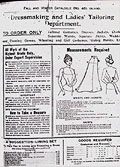 |
|
| |
 Eaton's
Fall/Winter Catalogue, no. 45, 1900-01, p. 3. Eaton's
Fall/Winter Catalogue, no. 45, 1900-01, p. 3.
|
|
| |
|
|
|
During the Victorian period, acceptable formal dress for middle-class
women
included long dresses, corsets, petticoats, and heeled shoes. Dressing
well and
following fashion meant a great deal to many women. To find reasonably
priced
stylish clothing, Canadian women increasingly turned to mail-order
catalogues
that did not disappoint. Catalogue shoppers could buy their clothing
ready-made
or send in their measurements for made-to-order tailored suits.
A strong clothing department for women was a necessity for both
department
stores and mail-order catalogues, since the ability to provide fashionable
women's
dress reflected well on the quality and novelty of the other departments.
The
women's clothing department had its own skilled buyer who was an
expert
in finding high quality merchandise at reasonable prices from suppliers in
Canada
and abroad. Thus, Canadian women from both urban and rural settings became
acquainted
with new fashion trends from the United States, the United Kingdom, and
Germany.
|
Critics of Fashionable Dress
The proliferation of women's fashionable dress had its critics,
however,
and several attempts were made to reform women's dress. Dress reform
associations
were established in the United States, Britain, Germany, and other
European countries,
where concerned members discussed and promoted alternate styles of dress.
There
was no shortage of problems identified with women's dress. First,
Victorian
middle-class women's dresses were too tight and restricted them to
passive,
indoor pursuits. Second, an uneven distribution of clothing and exposure
to drafts
caused body temperatures to fluctuate. Third, too many young women wore
"showy
and vulgar" dress characterized by excessive fur, feathers, and
ribbon;
and finally, tightly laced corsets and narrow shoes caused a multitude of
problems
for women and their offspring.
| |
 |
|
| |
 The
effects of wearing tight-fitting shoes as depicted by Dr. B. G. Jefferis
and J. L. Nichols in The Household Guide or Domestic Cyclopedia (Toronto:
J. L. Nichols Company Limited, 1894), p. 291. This almanac was sold
through the Eaton's catalogue. The
effects of wearing tight-fitting shoes as depicted by Dr. B. G. Jefferis
and J. L. Nichols in The Household Guide or Domestic Cyclopedia (Toronto:
J. L. Nichols Company Limited, 1894), p. 291. This almanac was sold
through the Eaton's catalogue.
|
|
| |
|
|
|
Medical conditions attributed to wearing fashionable dress included
abnormal
menstruation, miscarriage, breast tumours, weakened abdominal muscles,
abnormally
shaped livers, feet, and spines, cracked ribs, shortness of breath, an
irregular
heartbeat, tuberculosis and anaemia.
There were no formal dress reform associations in Victorian Canada, so
it
was the physicians and, in particular, the newly trained gynaecologists,
who
were most prominent in the discussion of dress reform. Their medical
knowledge
of women's bodies and their expertise in treating them produced a
maternal
image of women that was endorsed in social purity literature and popular
advice
books. Physicians, moral reformers, and social purity advocates, like
members
of the Woman's Christian Temperance Union (WCTU), urged women to
reflect
on the perceived impact of tight clothing on their health. They also urged
young
women to dress modestly and "appropriately" according to
prescribed
class dress codes.
|
Mail-order Companies and the Clothing
Debate
| |
 |
|
| |
 Ball's
Health Preserving Corset as advertised in Dominion Sanitary Journal,
6 (2) (November 1883): 62. Ball's
Health Preserving Corset as advertised in Dominion Sanitary Journal,
6 (2) (November 1883): 62.
|
|
| |
|
|
|
The role of department store catalogues and mail-order service in the
promotion
of dress reform was complex. Since girls and women constituted the entire
market
for corsets and fancy dress, dress reformers' opposition to
fashionable
dress was considered an obstacle to sales.
| |
 |
|
| |
 Corsets.
Eaton's Spring/Summer Catalogue, 1893, p. 15. Corsets.
Eaton's Spring/Summer Catalogue, 1893, p. 15.
|
|
| |
|
|
|
Mail-order companies acknowledged the clothing debate, as the following
catalogue
advertisement indicates: "The doctors claim the corset as their best
friend;
but in spite of doctors and dress reformers, a new corset makes its
appearance
every little while. And the women buy them of course they do."
Corset manufacturers recognized the changing attitudes towards health
and
fitness, and developed alternative products for this segment of the
market. Some
companies included physicians' testimonies that properly fitted
corsets
could be "health preserving," as was the case for Ball's
corsets
advertised in the Eaton's catalogue and medical journals.
"Healthy
corsets" were made using new techniques such as steam moulding to
replace
rigid whalebone stays, and by using coraline, an elasticized cotton fabric
that
increased flexibility.
| |
 |
|
The Lily steam moulded
corset
made with Coraline and Ball's Corset. Eaton's Fall/Winter Catalogue,
1887-88, p. 64.
|
 |
|
|
Reform Woollen Undergarments
Wearing woollen clothing or one-piece combination underclothes was a
popular
commercial solution for the problem of regulating body temperatures. One
of the
most prominent physicians to enter the dress reform market was the German
doctor,
Gustave Jaeger, who created his own medical woollen clothing system. He
advocated
wearing wool next to the skin, and outlined his theories and sanitary
clothing
system in his book Health Culture, first published in English in
1887.
| |
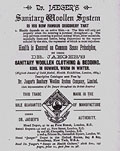 |
|
Dr. Jaeger Sanitary Woollen
System as seen in Dr. Jaeger's Sanitary Woollen System Co. Catalogue,
New York, 1886.
|
 |
|
| |
| |
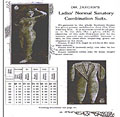 |
|
Dr. Jaeger's ladies'
combination
suits, as advertised in Dr. Jaeger's Sanitary Woollen System Co. Catalogue,
New York, 1886, p. 25.
|
 |
|
| |
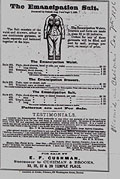 |
|
| |
 Canadian
testimonials for the Emancipation Suit, from the Report of the Committee
on Dress of the New England Women's Dress Reform Club, 1876. Canadian
testimonials for the Emancipation Suit, from the Report of the Committee
on Dress of the New England Women's Dress Reform Club, 1876.
|
|
| |
|
|
|
Dr. Jaeger originally sold his clothing exclusively through his London
store
and his own catalogue. Before woollen underclothes or combination suits
became
readily available in Canada, there is evidence that some Canadian women
placed
orders directly from the catalogue of the New England Dress Reform
Club.
Mrs. James MacPherson from St. John's, Quebec wrote on June 15,
1876:
"[P]lease send as soon as possible another Emancipation Waist, 23
inches,
for which find enclosed $2.00. I have had two of them already, and find
they
give entire satisfaction."
| |
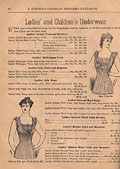 |
|
| |
 Ladies'
Woollen Underwear. Simpson's Spring/Summer Canadian Shoppers Handbook,
1896, No. 56, p. 38. Ladies'
Woollen Underwear. Simpson's Spring/Summer Canadian Shoppers Handbook,
1896, No. 56, p. 38.
|
|
| |
|
|
|
By the late 1880s, however, Dr. Jaeger was selling his woollen reform
clothing
through selected retailers worldwide including Eaton's. In 1888, one
year
after Dr. Jaeger's book Health Culture was published and
made
available in Canada, his clothes were introduced to Eaton's and
Simpson's
catalogue readers. Throughout the last two decades of the 19th century,
there
was a marked increase in the number of natural wool items available in
mail-order
catalogues.
| |
 |
|
| |
 Stuttgarter
sanitary combination suits as seen in Eaton's Fall/Winter Catalogue,
1894. Stuttgarter
sanitary combination suits as seen in Eaton's Fall/Winter Catalogue,
1894.
|
|
| |
|
|
|
Eaton's and Simpson's carried English and German brand
names of
woollen undergarments that were inspired by Dr. Jaeger's sanitary
wool
system. Stuttgarter manufactured a popular line of women's woollen
underclothes
as well as men's and children's wear and knee warmers.
Stuttgarter
advertisements contained testimonials from "'leading medical
experts
" that extolled the benefits of the whole family clothed in
Stuttgarter
undergarments year round. The advertisement promised that their
"pure,
undyed sanitary wool would protect the wearer from colds and infections of
the
lungs."
The 1894 Eaton's catalogue also included natural wool body bands
for
men. Previously, advertisements had marketed body bands to pregnant women,
children,
and infants as protection from respiratory ailments.
|
"Health Brand"
Underclothing
| |
 |
|
| |
 Advertisment
for Health Brand underwear in The Dry Goods Review, 4 (6) (1894): 21. Advertisment
for Health Brand underwear in The Dry Goods Review, 4 (6) (1894): 21.
|
|
| |
|
|
|
A new Canadian line of reform woollen underclothing was created in the
late
1890s from the Montreal Silk Mills, and appropriately called "Health
Brand."
The link to health and medicine was created not only through its name, but
also
through the advertising, which included endorsements by medical
authorities.
Although Health Brand was based on Dr. Jaeger's clothing system, it
clearly
outsold Dr. Jaeger in Canada. It was available from the Eaton's
catalogue,
and was widely advertised in newspapers, magazines, and trade journals
like the
Dry Goods Review. In an 1896 issue, a full-page advertisement for
Health
Brand stated that it was "endorsed" by Mrs. Jean Morris Ellis
of
Montréal in a dress reform lecture. Mrs. Ellis and physicians alike
emphasized
the importance of wearing wool garments year round and recommended Health
Brand
for its superior quality. |
Women's Sports Clothing
| |
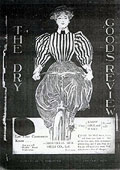 |
|
| |
 The
Dry Goods Review, 6 (1) (January 1896): cover. The
Dry Goods Review, 6 (1) (January 1896): cover.
|
|
| |
|
|
|
Catalogues and trade journals also served as a direct means to
communicate
medical knowledge and new ideas about women's role in society,
particularly
when it promoted the merchandise they were trying to sell. For example, an
article
by Dr. W. H. Fenton on women and cycling was summarized in an 1896 issue
of the
Dry Goods Review. Dr. Fenton strongly endorsed cycling and
exercise
for women, and encouraged women to wear high collars, tight-fitting
sleeves,
and warm absorbent undergarments to improve circulation and to remove
"the
aches and pains that tend to make her prematurely old."
During the cycling boom in the 1890s, women were considered an
important market
for bicycle manufacturers. Numerous bicycle companies printed their own
catalogues
during this period, and often included images of women riding bicycles.
| |
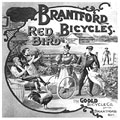 |
|
Cover of the Brantford Red
Bird Bicycle Catalogue, 1898, from Glen Norcliffe, The Ride to Modernity:
The Bicycle in Canada, 1869-1900 (Toronto: University of Toronto Press,
2001), p. 146.
|
 |
|
| |
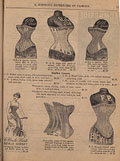 |
|
Bicycle corsets. Simpson's
Spring/Summer Catalogue, 1896, p. 79.
|
 |
Department-store catalogues followed the cycling trend and carried the
appropriate
riding attire and accessories including bicycle corsets.
While articles in the Dry Goods Review encouraged retailers to
carry
bright, silk knickerbockers trimmed with lace and ribbon, mail-order
catalogues
carried the traditional serge or wool cycling skirts in dark colours.
| |
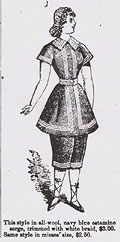 |
|
| |
 Lady's
bathing suit. Eaton's Spring/Summer Catalogue, 1894, p. 30. Lady's
bathing suit. Eaton's Spring/Summer Catalogue, 1894, p. 30.
|
|
| |
|
|
|
Women who enjoyed sports were not limited to cycling, and by the early
20th
century, golfing, riding, tennis, and swimming were also promoted as
suitable
sports. Naturally, mail-order catalogues supplied the necessary clothing
and
accessories. The Eaton's catalogue carried a line of navy-blue serge
bathing
suits that were very popular among women at the time.
| |
 |
|
Young women on the beach,
ca. 1894-95.
|
 |
|
|
Conclusion
With the rise of a strong consumer culture in the late 19th and early
20th
centuries, consumers had unprecedented choices in determining how they
wanted
to dress. Since women continued to wear corsets despite medical and
prescriptive
advice to the contrary, mail-order companies supplied the broad range of
consumer
demands by offering something for everyone: traditional women's
dress and
accessories, reform corsets, and dress-reform woollen underclothing, as
well
as clothing for women who increasingly participated in sports and leisure
activities.
Indeed, "healthy" corsets and reform woollen underclothes
were
the first evidence of Canada's foray into dress reform. Regulating
healthy
bodies continued to be linked to the regulation of body temperatures
through
woollen dress. The popularity of Dr. Jaeger's medical clothing
system inspired
the popular Montréal-based Health Brand line, underscoring how
health
was the main issue in retailing reform clothing in late 19th century
Canada.
Mail-order catalogues like Eaton's and Simpson's played a
large role
in introducing these reform garments to women throughout Canada.
|
| |
|
|